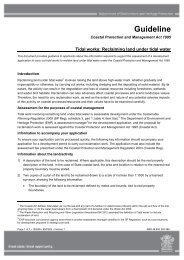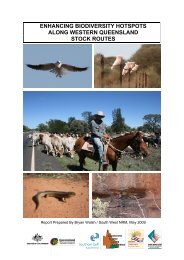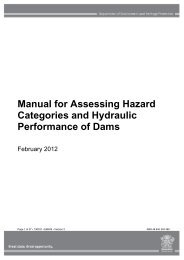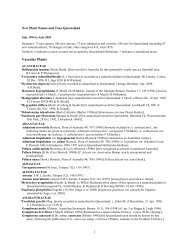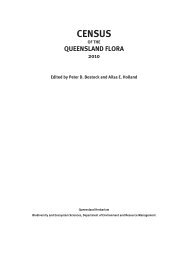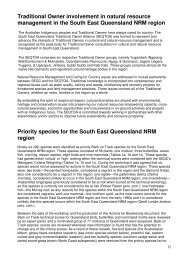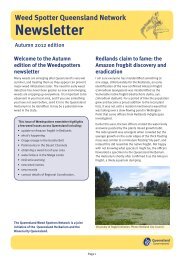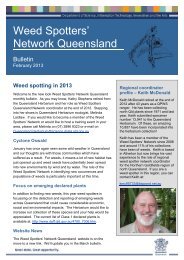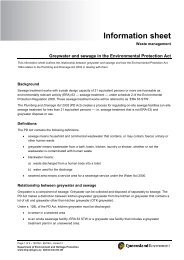Distribution, abundance and biology of Group V humpback whales ...
Distribution, abundance and biology of Group V humpback whales ...
Distribution, abundance and biology of Group V humpback whales ...
You also want an ePaper? Increase the reach of your titles
YUMPU automatically turns print PDFs into web optimized ePapers that Google loves.
During the northern migration there is a distinct peak in<br />
<strong>abundance</strong> during late June <strong>and</strong> early July observed <strong>of</strong>f<br />
North Stradbroke Isl<strong>and</strong> (Paterson 1984) but no such peak<br />
is observed during the southern migration that occurs<br />
in late August <strong>of</strong>f the Whitsunday Isl<strong>and</strong>s (Malcom <strong>and</strong><br />
Duggan 1997). In Hervey Bay, the Pacifi c Whale Foundation<br />
(1997) reported <strong>humpback</strong>s appearing at earlier dates<br />
in successive years. The peak <strong>abundance</strong> <strong>of</strong> <strong>humpback</strong>s<br />
in Hervey Bay varies from days to weeks (Corkeron et<br />
al.1994). Dawbin (1956) observed a variation in the peak<br />
<strong>abundance</strong> <strong>of</strong> migrating <strong>humpback</strong>s past New Zeal<strong>and</strong> to be<br />
as much as fi ve-<strong>and</strong>-a-half weeks.<br />
The structure <strong>of</strong> pods was identifi ed by a genetic study by<br />
Brown et al.(1995). They noted the northward migrating<br />
pods were signifi cantly smaller than southward migrating<br />
pods <strong>and</strong> that more male <strong>humpback</strong> <strong>whales</strong> were found in<br />
the larger pods than females. The most common pod type<br />
observed during the study was the male-female pair, which<br />
is suggestive <strong>of</strong> either mating on migration <strong>and</strong>/or mate<br />
guarding.<br />
There is growing support for the hypothesis that not all<br />
females migrate annually to winter grounds but remain on<br />
the feeding grounds during rest years, or produce <strong>of</strong>fspring<br />
in the higher latitudes <strong>of</strong> Antarctica (Chittleborough 1958a;<br />
Brown et al.1995; Craig <strong>and</strong> Herman 1997; Mikhalev 2000).<br />
Chittleborough (1965) <strong>and</strong> Brown et al.(1995) documented<br />
the ratio <strong>of</strong> migrating <strong>Group</strong> V males to females, sampled in<br />
south-east Queensl<strong>and</strong>, <strong>and</strong> is approximately 2:1. This is a<br />
similar ratio for other <strong>humpback</strong> stocks in the North Pacifi c<br />
(Medrano et al.1994; Calambokidis 2000; Craig <strong>and</strong> Herman<br />
2000). However, researchers from the North Atlantic argue<br />
that there is no evidence for a male-biased sex ratio in<br />
wintering <strong>humpback</strong>s in the North Atlantic.<br />
The migration southward may be delayed by some<br />
individuals due to their mating drive being stronger than<br />
hunger as individuals <strong>and</strong> groups <strong>of</strong> <strong>humpback</strong> <strong>whales</strong> have<br />
been observed to continue to seek mates, at least in the<br />
early stage <strong>of</strong> the southern migration (Paterson 1984).<br />
5.3 Site fi delity <strong>and</strong> habitat preference<br />
Humpback <strong>whales</strong> exhibit a high degree <strong>of</strong> site fi delity<br />
both towards feeding <strong>and</strong> wintering grounds (Clapham et<br />
al.1993). Urban et al.(2000) determined that the migratory<br />
movements <strong>of</strong> eastern Pacifi c <strong>humpback</strong>s were clearly<br />
non-r<strong>and</strong>om. Photographic comparisons between areas<br />
showed clear evidence for preferred migratory destinations.<br />
Kaufmann (1990) describes the movements <strong>of</strong> an adult<br />
<strong>humpback</strong> whale sighted in Antarctic Area V that was<br />
resighted 19 months later in Platypus Bay, Queensl<strong>and</strong>,<br />
Australia. The re-sightings were verifi ed using both tail-fl uke<br />
<strong>and</strong> lateral body markings. The resighting <strong>of</strong> this animal<br />
is the fi rst photographic documentation <strong>of</strong> movement<br />
between the described areas, <strong>and</strong> provides support for the<br />
assumption, based upon discovery tags, that <strong>whales</strong><br />
found along the east cost <strong>of</strong> Australia migrate from<br />
Antarctic Area V.<br />
Genetic studies demonstrate that, despite the nearly<br />
unlimited migratory potential <strong>of</strong> the species, there is a<br />
striking degree <strong>of</strong> genetic structure both within <strong>and</strong><br />
between oceanic populations <strong>of</strong> <strong>humpback</strong> <strong>whales</strong><br />
(Baker et al.1994). Several authors have concluded that<br />
site fi delity in <strong>humpback</strong>s is a maternally driven trait<br />
(Baker et al.1994; Palsbøll et al.1995; Urban et al.2000).<br />
Photo-identifi cation studies are not consistent in their<br />
fi ndings in relation to sex biases in site fi delity. Garrigue<br />
et al.(2000) <strong>and</strong> Sladen et al.(1999) concur in their<br />
conclusions <strong>of</strong> male exhibiting less fi delity than females. In<br />
New Caledonia Garrigue et al.(2000) found that there is an<br />
interchange <strong>of</strong> males between winter grounds. In Hawaii<br />
males are more likely to w<strong>and</strong>er between wintering grounds<br />
than females (Sladen et al.1999). However, a photoidentifi<br />
cation study by Craig <strong>and</strong> Herman (1997) suggests<br />
males show greater site fi delity than females in Hawaiian<br />
wintering grounds.<br />
Baker et al.(1994) concluded from their genetic data that<br />
there was no obvious evidence <strong>of</strong> sex biases in site fi delity<br />
<strong>and</strong> that <strong>humpback</strong>s used a strategy that is a combination <strong>of</strong><br />
imprinting <strong>and</strong> genetic traits to return to the winter grounds.<br />
Craig <strong>and</strong> Herman (2000) used photographic techniques<br />
to investigate sex differences in site fi delity <strong>and</strong> migration.<br />
They concluded that the wintering areas utilised by breeding<br />
females is dependent upon their reproductive status.<br />
Gregr <strong>and</strong> Trites (2000) used positional information <strong>and</strong><br />
oceanographic data (bathymetry, temperature, <strong>and</strong> salinity)<br />
to predict critical habitat <strong>of</strong>f the coast <strong>of</strong> British Columbia<br />
for fi ve whale species including <strong>humpback</strong> <strong>whales</strong>. Using<br />
six predictor variables (month, depth, slope, depth class,<br />
<strong>and</strong> sea surface temperature <strong>and</strong> salinity) the model<br />
developed identifi ed critical habitat for sei, fi n, <strong>and</strong> male<br />
sperm <strong>whales</strong>. However, due to the small sample size, the<br />
model was relatively insensitive to the predictor variables<br />
for <strong>humpback</strong> <strong>whales</strong>. However, the habitat predictions<br />
did identify <strong>humpback</strong> whale habitat in sheltered bays<br />
<strong>and</strong> straits throughout the coast. The application <strong>of</strong> this<br />
model could be considered for identifying <strong>humpback</strong> whale<br />
habitat in Queensl<strong>and</strong>. The high degree <strong>of</strong> site fi delity<br />
exhibited by <strong>humpback</strong>s, especially females, is an important<br />
consideration for the management <strong>and</strong> planning <strong>of</strong> marine<br />
protected areas.<br />
The high degree <strong>of</strong> site fi delity exhibited by <strong>humpback</strong>s<br />
is likely to have implications for breeding success. It has<br />
been suggested site fi delity is maternally driven <strong>and</strong> that<br />
females with calves favour habitats that provide protection<br />
from predators <strong>and</strong> rough sea conditions. If this is the case,<br />
there are only limited areas breeding females can utilise.<br />
If females have already expended huge energy budgets<br />
during migration, the energy required to search for other<br />
suitable breeding habitat may be enough to cause a decline<br />
in breeding success over a long period.<br />
10 • <strong>Distribution</strong>, <strong>abundance</strong> <strong>and</strong> <strong>biology</strong> <strong>of</strong> <strong>Group</strong> V <strong>humpback</strong> <strong>whales</strong> Megaptera novaeangliae: A review • August 2002



